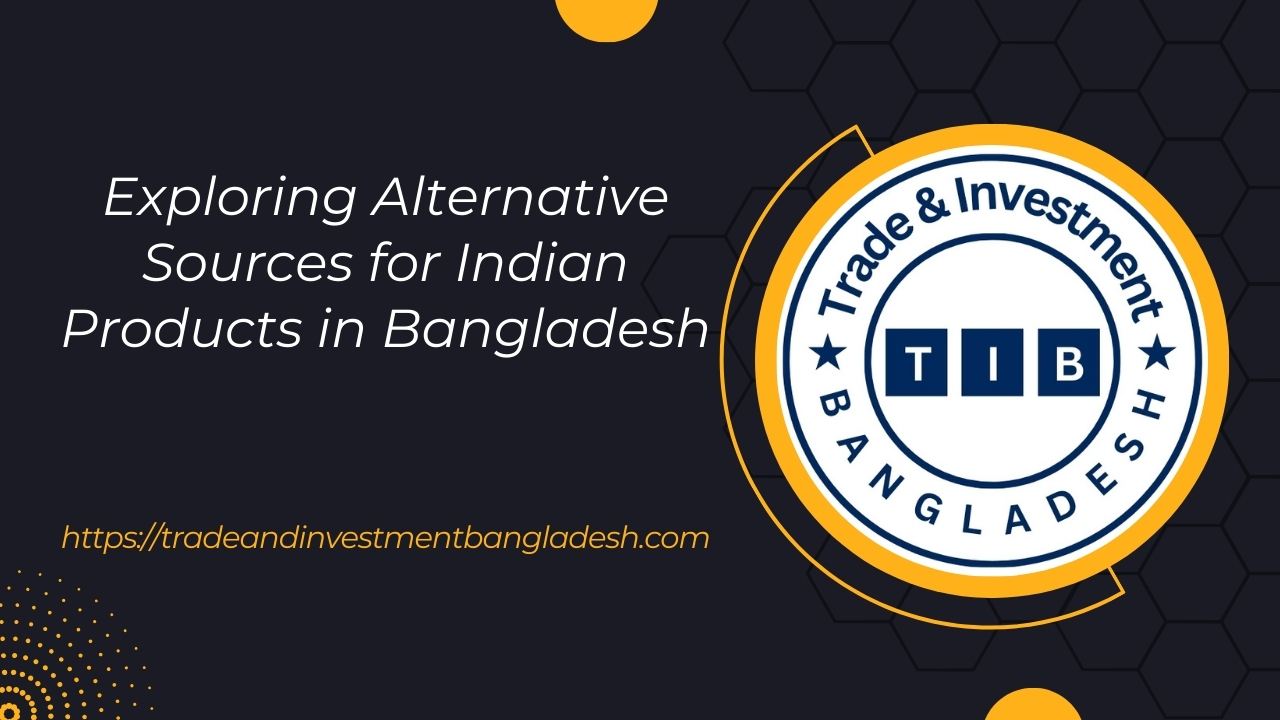Exploring Alternative Sources for Indian Products in Bangladesh
Md. Joynal Abdin, BBA (Hons.), MBA
Founder & CEO, Trade & Investment Bangladesh (TIB)
Secretary General, Brazil Bangladesh Chamber of Commerce & Industry (BBCCI)
In the wake of the recent political upheaval following the fall of the Hasina government, Bangladesh has found itself navigating a challenging diplomatic landscape, particularly with its long-standing neighbor, India. Historically close economic partners, the relationship between the two nations has soured due to a series of political and social tensions. Negative comments from high-profile Indian leaders like BJP’s Amit Shah, who has repeatedly made derogatory remarks about Bangladesh and its people, have further strained ties. Additionally, India’s perceived role in sheltering criminals from Bangladesh has intensified the discord, leading to growing mistrust between the two countries.
The political friction has been compounded by a wave of fake propaganda circulating in India, falsely portraying Bangladesh in a negative light. These campaigns aim to discredit Bangladesh’s political stability and economic growth, stirring animosity among Indian citizens. As a result, the adverse political environment has sparked debates in Bangladesh regarding the over-reliance on India for key imports, with calls for exploring alternative sourcing options gaining traction. In light of these developments, Bangladeshis are beginning to seek new trade partners and markets to diversify their import dependencies.
Traditionally, Bangladesh has imported a wide array of products from India, ranging from textiles, pharmaceuticals, and machinery to raw materials such as cotton, cement, and chemicals. These imports have been essential to many local industries, with Indian goods once regarded as affordable and accessible. However, as political relations deteriorate, many Bangladeshi businesses are re-evaluating their reliance on Indian products, seeking to reduce vulnerabilities in their supply chains and minimize the risk of disruption.
Several alternative sources have emerged as potential suppliers of these vital goods. For example, Bangladesh can look to China, Vietnam, and Turkey for textiles and machinery, all of which offer competitive prices and high-quality products. In the pharmaceutical sector, South Korea and the European Union present viable options for medicine and medical supplies. Countries such as Indonesia, Pakistan, and Malaysia can provide Bangladesh with raw materials like cotton and cement, helping to balance out its import sources while avoiding over-dependence on a single nation.
In the current geopolitical climate, diversifying Bangladesh’s import sources is not only a strategic economic move but also a necessary step to safeguard its industries from external political shocks. By forging stronger ties with alternative markets, Bangladesh can build a more resilient trade network, free from the vulnerabilities posed by political tensions with India.
Why Bangladesh should go for alternative sources?
For the past fifteen years, Bangladesh’s relationship with India has been marked by political manipulation and economic pressures that have increasingly pushed the country towards seeking alternative sources for essential commodity imports. The pattern of Indian interference in Bangladesh’s internal affairs, particularly regarding its electoral process, has raised deep concerns about the sovereignty and long-term stability of Bangladesh. Starting with the 2014 elections, followed by the highly disputed 2018 and 2024 elections, India has been accused of supporting the dictatorial rule of Sheikh Hasina against the will of the Bangladeshi people. India’s unrelenting backing of the Hasina government, despite widespread allegations of voter suppression, manipulation, and human rights violations, has severely undermined the democratic process in Bangladesh. This has fostered a growing distrust towards India, compelling Bangladesh to rethink its heavy dependence on its neighbor for imports.
One of the most glaring examples of India’s exploitative policies towards Bangladesh has been the signing of one-sided treaties that primarily serve India’s interests. The transit agreements, for instance, have enabled India to use Bangladeshi roads and ports to transport goods to its northeastern states, but Bangladesh has received little in return. Moreover, India has continually blocked Bangladesh’s access to trade routes with Nepal and Bhutan, restricting Bangladesh’s ability to engage in regional commerce independently. These actions have made it clear that India prioritizes its own strategic gains at the expense of Bangladesh’s national interest. Furthermore, the Indian Defense Minister, Rajnath Singh, has issued war threats against Bangladesh, exacerbating tensions and revealing a blatant disregard for diplomacy and regional stability.
Compounding these issues are the inflammatory and derogatory comments made by key figures in India, such as BJP leader Amit Shah. Shah has repeatedly made statements that insult Bangladeshis, labeling them as “infiltrators” and associating them with criminal activity. These remarks, alongside India’s role in sheltering militants and criminals in the Chittagong Hill Tracts region, have fueled anti-Indian sentiment among the Bangladeshi population. Indian media has also contributed to this toxic atmosphere by running a coordinated propaganda campaign aimed at undermining Bangladesh’s progress and portraying it in a negative light. Such actions are not only harmful to diplomatic relations but have also sparked discussions within Bangladesh about the need to reduce dependency on a country that repeatedly disrespects its sovereignty.
Economically, India’s exploitative trade policies have further justified Bangladesh’s move to explore alternative sources for commodity imports. In times of crisis, India has often imposed export bans on critical goods, such as onions, when Bangladesh needed them the most. These bans, usually enacted without prior notice, have caused severe disruptions in Bangladesh’s supply chain, leading to price hikes and shortages. India has also imposed high tariffs on Bangladeshi imports, making it difficult for Bangladesh to balance trade relations. Such practices have underscored the necessity for Bangladesh to diversify its import sources and reduce its reliance on India, which uses trade as a political tool.
Given these persistent challenges, Bangladesh must urgently pursue alternative sources for its key commodity imports. Countries like China, Vietnam, Turkey, and Indonesia offer competitive products ranging from textiles to raw materials, and their markets are far more stable and reliable in terms of supply chains. By diversifying its imports, Bangladesh can protect itself from the economic manipulation that it has long faced from India. Establishing stronger trade relationships with these alternative partners will not only provide Bangladesh with a wider array of choices but also allow the country to assert its independence on the global stage.
The years of political, economic, and diplomatic exploitation by India make it clear that Bangladesh should no longer rely so heavily on its neighbor for imports. By seeking alternative sources, Bangladesh can protect its sovereignty, stabilize its economy, and forge new international partnerships that respect its independence and long-term interests.

What are the products Bangladesh is importing from India?
Bangladesh has traditionally relied heavily on India for a wide range of imports. These imports encompass essential raw materials, industrial goods, and consumer products, which play a crucial role in the country’s economy. Below is a detailed breakdown of Bangladesh’s key import items from India, with relevant statistics, import volumes, prices, and sources within India.
- Cotton
- Import Volume: Cotton is one of Bangladesh’s most significant imports from India, driven by the country’s robust textile and garment industry. In the fiscal year 2022-2023, Bangladesh imported over 2.5 million bales of cotton from India.
- Import Price: The average price of cotton imported from India fluctuates between USD 1.50 and USD 2.00 per kg, depending on the global cotton market and demand.
- Key Sources: Major cotton-producing regions in India include Gujarat, Maharashtra, and Telangana, which supply the bulk of cotton to Bangladesh.
- Textiles and Fabrics
- Import Volume: Besides raw cotton, Bangladesh imports large volumes of finished textiles and fabrics from India, including woven fabrics and yarn. In 2022, Bangladesh imported around USD 2 billion worth of textiles from India.
- Import Price: Prices for different fabric categories vary. For instance, woven cotton fabric ranges from USD 1.50 to USD 5.00 per meter, while synthetic fabrics can range from USD 1.00 to USD 3.50 per meter.
- Key Sources: Indian states like Tamil Nadu, Gujarat, and Punjab are prominent suppliers of these textile products.
- Vehicles and Automobile Parts
- Import Volume: Automobiles and parts constitute a significant portion of Bangladesh’s imports from India. In 2022, Bangladesh imported around USD 1.1 billion worth of automobiles, including commercial vehicles, buses, and two-wheelers.
- Import Price: Prices vary depending on the vehicle type. For instance, two-wheelers such as motorcycles are priced between USD 500 to USD 1,500, while buses and commercial vehicles range from USD 15,000 to USD 50,000 per unit.
- Key Sources: West Bengal and Maharashtra are important regions for the assembly and export of vehicles to Bangladesh. Prominent Indian automobile companies like Tata Motors, Mahindra, and Bajaj dominate this export segment.
- Chemicals and Pharmaceuticals
- Import Volume: Bangladesh relies on India for various chemicals, including dyes, pigments, and active pharmaceutical ingredients (APIs). In 2022, chemical and pharmaceutical imports from India amounted to nearly USD 900 million.
- Import Price: API prices fluctuate based on the type of chemical. For instance, basic APIs may cost between USD 50 to USD 200 per kilogram, while specialized chemicals are priced higher.
- Key Sources: Indian states like Gujarat and Maharashtra are major chemical and pharmaceutical production hubs. Indian companies such as Dr. Reddy’s, Sun Pharmaceuticals, and Cipla play a key role in supplying Bangladesh with APIs.
- Fruits and Vegetables
- Import Volume: India is a significant supplier of perishable goods such as onions, garlic, and various fruits. In 2022, Bangladesh imported over USD 450 million worth of fruits and vegetables from India.
- Import Price: The price of perishable imports, particularly onions, is highly volatile. For example, onion prices range from USD 0.30 to USD 1.50 per kg, depending on the season and supply conditions.
- Key Sources: Agricultural regions like Maharashtra, Karnataka, and Andhra Pradesh supply much of Bangladesh’s fruits and vegetables, especially onions and garlic.
- Cereals (Wheat and Rice)
- Import Volume: Bangladesh frequently imports cereals from India, particularly wheat and rice, to meet local demand. In 2022, Bangladesh imported around 1.2 million metric tons of wheat and 300,000 metric tons of rice from India.
- Import Price: The average price for wheat ranges from USD 200 to USD 300 per metric ton, while rice is priced between USD 300 to USD 450 per metric ton.
- Key Sources: Northern Indian states like Punjab, Haryana, and Uttar Pradesh are major suppliers of rice and wheat to Bangladesh.
- Iron and Steel
- Import Volume: Bangladesh imports substantial amounts of iron and steel from India to fuel its booming construction and infrastructure sectors. In 2022, Bangladesh imported around USD 1.5 billion worth of iron and steel products.
- Import Price: Iron and steel prices are subject to global market trends, ranging between USD 600 and USD 1,200 per metric ton depending on the product type.
- Key Sources: Indian states like Odisha, Jharkhand, and Chhattisgarh are key iron and steel producers that supply Bangladesh’s steel demand.
- Plastic and Plastic Products
- Import Volume: Plastic and plastic-based products are a crucial part of Bangladesh’s imports from India, amounting to approximately USD 400 million in 2022.
- Import Price: The price of plastic resins varies from USD 1,000 to USD 1,500 per metric ton, while finished plastic goods range from USD 2.00 to USD 10.00 per unit, depending on the product type.
- Key Sources: States like Gujarat and Tamil Nadu are major producers of plastic goods in India.
- Petroleum Products
- Import Volume: Bangladesh imports various refined petroleum products from India to meet its energy needs. In 2022, the country imported around USD 800 million worth of petroleum products.
- Import Price: The price of petroleum products, such as diesel and gasoline, fluctuates between USD 70 and USD 100 per barrel, depending on global oil prices.
- Key Sources: Indian refineries in Assam, West Bengal, and Gujarat are primary suppliers of petroleum products to Bangladesh.
- Electrical Machinery and Equipment
- Import Volume: Electrical machinery and equipment imports from India, including transformers, cables, and electrical components, amounted to approximately USD 700 million in 2022.
- Import Price: Electrical equipment prices vary widely. For example, transformers cost between USD 5,000 and USD 50,000 depending on capacity, while cables and wires range from USD 2.00 to USD 5.00 per meter.
- Key Sources: India’s industrial regions like Maharashtra and Tamil Nadu manufacture and export a significant share of these products to Bangladesh.
- Glass and Ceramics
- Import Volume: Bangladesh imports glass and ceramic products for both domestic and industrial use, with imports from India valued at around USD 300 million in 2022.
- Import Price: Glass and ceramic products such as tiles are priced between USD 5.00 and USD 20.00 per square meter.
- Key Sources: Gujarat and Rajasthan are major hubs for glass and ceramics production in India.
Summary of Bangladesh’s Imports from India:
- Total Import Volume (2022): Over USD 16 billion worth of goods.
- Key Import Items: Cotton, textiles, vehicles, chemicals, food items, iron and steel, electrical equipment, petroleum, and machinery.
- Key Indian States Supplying Imports: Gujarat, Maharashtra, West Bengal, Punjab, Tamil Nadu, Karnataka, Andhra Pradesh, Odisha, Jharkhand, and Chhattisgarh.
India has been a vital trade partner for Bangladesh for decades, supplying crucial materials and products across multiple industries. However, due to the shifting political and economic landscape, including trade restrictions and diplomatic tensions, Bangladesh is increasingly looking for alternative sources to diversify its imports and reduce its dependency on India.

Alternative Global Sources of these products:
Bangladesh’s need to diversify its import sources from India is driven by the desire to reduce its vulnerability to diplomatic tensions, political interference, and economic disruptions. There are several alternative global sources for the products Bangladesh traditionally imports from India. Below is a detailed overview of these alternative sourcing countries, major cities, harvest seasons or production cycles, pricing, and logistics.
- Cotton
- Sourcing Countries:
- United States (Texas, California)
- Brazil (Mato Grosso, Bahia)
- Uzbekistan (Andijan, Tashkent)
- Harvesting Season:
- USA: August to November
- Brazil: March to June
- Uzbekistan: September to October
- Pricing: The global price of cotton ranges between USD 1.50 and USD 2.50 per kg, with slight fluctuations depending on market conditions.
- Logistics & Trade Arrangements:
- Shipping cotton from the U.S. involves a longer transit time, usually 4–6 weeks to Chittagong port, while Brazilian exports take around 3–4 weeks. Uzbekistan has the advantage of being geographically closer, with transit times of 2–3 weeks.
- Bangladesh has established trade agreements with the U.S. and Brazil, making it feasible to import cotton under favorable trade terms like the Generalized System of Preferences (GSP).
- Textiles and Fabrics
- Sourcing Countries:
- China (Zhejiang, Guangdong)
- Vietnam (Ho Chi Minh City, Hanoi)
- Turkey (Istanbul, Bursa)
- Harvesting/Production Cycle: Fabric production is year-round in China, Vietnam, and Turkey, ensuring a continuous supply.
- Pricing: Woven cotton fabric costs around USD 1.50 to USD 4.00 per meter, while synthetic fabrics from Vietnam and China are priced between USD 1.00 and USD 3.00 per meter.
- Logistics & Trade Arrangements:
- Bangladesh has well-established shipping routes with China, with transit times of 2–3 weeks. Turkish fabrics typically take 3–4 weeks for shipping. Vietnam’s textiles can be shipped in about 2–3 weeks.
- Trade agreements like the Free Trade Agreement (FTA) with Turkey or China’s Belt and Road Initiative can facilitate reduced tariffs for textile imports.
- Vehicles and Automobile Parts
- Sourcing Countries:
- Japan (Tokyo, Osaka)
- South Korea (Seoul, Busan)
- Thailand (Bangkok, Rayong)
- Production Cycles: Vehicles and parts are manufactured year-round in these countries.
- Pricing: Japanese two-wheelers (e.g., Honda, Suzuki) range from USD 800 to USD 1,500, while buses and trucks cost between USD 20,000 and USD 50,000.
- Logistics & Trade Arrangements:
- Bangladesh imports vehicles from Japan, South Korea, and Thailand via the Chittagong and Mongla ports. The transit time from Japan and South Korea is about 2–3 weeks, while shipments from Thailand take around 1–2 weeks.
- Bangladesh benefits from competitive trade terms with these countries through regional trade partnerships under the Asia-Pacific Trade Agreement (APTA).
- Chemicals and Pharmaceuticals
- Sourcing Countries:
- Germany (Frankfurt, Hamburg)
- South Korea (Seoul, Incheon)
- Switzerland (Basel, Zurich)
- Production Cycles: API production is constant, though demand spikes can cause temporary shortages. Germany and Switzerland are home to some of the world’s largest pharmaceutical companies, like Bayer and Novartis.
- Pricing: Basic APIs range from USD 50 to USD 300 per kg, depending on the compound. Prices tend to be higher for advanced formulations.
- Logistics & Trade Arrangements:
- Germany and Switzerland supply APIs through air freight and sea routes. Shipping APIs from Europe takes approximately 2–3 weeks, while South Korea offers faster transit times of 1–2 weeks.
- Bangladesh imports under WTO rules and can leverage the Least Developed Country (LDC) provisions for lower import duties from these advanced economies.
- Fruits and Vegetables
- Sourcing Countries:
- China (Fujian, Guangdong)
- Pakistan (Sindh, Punjab)
- Egypt (Cairo, Alexandria)
- Harvesting Season:
- China: Onions (October–December), Garlic (May–July)
- Pakistan: Onions (November–January), Garlic (March–April)
- Egypt: Year-round cultivation of onions and garlic.
- Pricing: Onions are priced between USD 0.20 and USD 1.00 per kg, while garlic ranges from USD 0.50 to USD 2.00 per kg depending on the season.
- Logistics & Trade Arrangements:
- Imports from Pakistan and China typically take 1–2 weeks to arrive via sea or land routes. Egypt takes longer, with transit times of 3–4 weeks.
- Bangladesh has preferential trade agreements with China under the Asia-Pacific Trade Agreement (APTA), ensuring competitive pricing and lower tariffs.
- Cereals (Wheat and Rice)
- Sourcing Countries:
- Ukraine (Odesa, Kyiv)
- Thailand (Bangkok, Ayutthaya)
- Pakistan (Karachi, Lahore)
- Harvesting Season:
- Ukraine: Wheat (July–August)
- Thailand: Rice (November–January)
- Pakistan: Wheat (March–April), Rice (November–December)
- Pricing: Wheat ranges between USD 250 and USD 350 per metric ton, while rice varies from USD 350 to USD 500 per metric ton.
- Logistics & Trade Arrangements:
- Ukraine supplies wheat via Black Sea ports, with transit times of 4–5 weeks. Thailand and Pakistan ship rice to Bangladesh within 1–2 weeks.
- Bangladesh can take advantage of tariff-free imports from Thailand under the Bay of Bengal Initiative for Multi-Sectoral Technical and Economic Cooperation (BIMSTEC).
- Iron and Steel
- Sourcing Countries:
- China (Hebei, Jiangsu)
- South Korea (Busan, Pohang)
- Russia (Chelyabinsk, Lipetsk)
- Production Cycles: Steel production operates year-round in these countries, with demand-driven adjustments.
- Pricing: Iron and steel prices range between USD 600 and USD 1,200 per metric ton.
- Logistics & Trade Arrangements:
- Shipping steel from China takes about 2–3 weeks, from South Korea 1–2 weeks, and from Russia around 4–5 weeks.
- Bangladesh has strong trade ties with China under the APTA, providing tariff reductions. Additionally, Bangladesh benefits from regional trade initiatives with South Korea and China for smooth iron and steel imports.
- Plastic and Plastic Products
- Sourcing Countries:
- Vietnam (Ho Chi Minh City, Hanoi)
- Malaysia (Kuala Lumpur, Penang)
- Thailand (Bangkok, Pattaya)
- Production Cycles: Plastic production operates year-round, though certain seasons may see higher production outputs.
- Pricing: Plastic resins range from USD 1,000 to USD 1,500 per metric ton, while finished goods can range from USD 2.00 to USD 10.00 per unit.
- Logistics & Trade Arrangements:
- Shipping plastic goods from Vietnam and Malaysia takes around 1–2 weeks, while Thailand requires approximately 2–3 weeks.
- Bangladesh imports plastics under favorable terms with Vietnam and Malaysia due to regional trade agreements, including the BIMSTEC and ASEAN.
- Petroleum Products
- Sourcing Countries:
- Saudi Arabia (Riyadh, Jeddah)
- Kuwait (Kuwait City)
- United Arab Emirates (Dubai, Abu Dhabi)
- Production Cycles: Petroleum production in the Middle East is year-round, with output adjusted according to global demand.
- Pricing: The average price for crude oil ranges from USD 70 to USD 100 per barrel, though this fluctuates based on OPEC decisions.
- Logistics & Trade Arrangements:
- Oil shipments from the Middle East take approximately 2–3 weeks. Bangladesh has long-standing trade arrangements with Saudi Arabia and Kuwait under bilateral energy trade agreements.
- Bangladesh can secure favorable pricing by maintaining strong diplomatic and trade relationships with these Gulf countries.
- Electrical Machinery and Equipment
- Sourcing Countries:
- China (Shenzhen, Guangzhou)
- Japan (Tokyo, Osaka)
- South Korea (Seoul, Incheon)
- Production Cycles: Year-round production of electrical machinery, with constant innovation in technology.
- Pricing: Transformers cost between USD 5,000 and USD 50,000, while cables and components range from USD 2.00 to USD 5.00 per meter

Required Government Support for this alternative sourcing:
To successfully transition Bangladesh’s import dependency away from India and establish a robust network of alternative global suppliers, the government must implement comprehensive measures. This would include policy support, fiscal incentives, and strong diplomatic engagement. Below is a detailed breakdown of the required government support to facilitate alternative sourcing for key products:
1. Policy Support
A well-structured policy framework is crucial for diversifying Bangladesh’s import sources. Key policy actions should include:
- Formulation of Import Diversification Policies: The government must establish policies that prioritize trade relations with countries other than India. This could be formalized in a “National Import Diversification Strategy,” which encourages sourcing from a wide range of nations across different sectors. Special attention should be given to identifying alternative suppliers for critical imports like cotton, pharmaceuticals, steel, and food items.
- Ease of Doing Business Reforms: To make Bangladesh an attractive destination for new trading partners, reforms in customs procedures, reducing bureaucratic red tape, and simplifying import licensing are essential. Digitalizing the import approval system will ensure faster processing times for goods coming from new sourcing countries.
- Strengthening Regulatory Frameworks: To ensure the smooth entry of goods from new sources, the government should update regulatory frameworks for product standards and safety certifications, making them more aligned with global standards. This ensures that products from various markets can seamlessly enter Bangladesh without unnecessary delays or hurdles.
- Facilitating Bilateral & Multilateral Trade Agreements: Negotiating new bilateral trade agreements with key alternative sourcing countries, especially those in the ASEAN region, Latin America, and Europe, can help Bangladesh secure favorable terms. Multilateral trade agreements with regional blocs like ASEAN, the European Union, and MERCOSUR should be targeted to boost trade opportunities beyond the Indian market.
- Encouraging Import Substitution: The government should also promote industries that can reduce Bangladesh’s dependence on imports by developing domestic alternatives. This could be particularly beneficial for goods such as textiles, pharmaceuticals, and agricultural products. Encouraging the development of local industries will lessen import burdens and create employment opportunities.
2. Fiscal Support
To incentivize importers to diversify their sourcing countries, the government must provide a variety of fiscal benefits:
- Reduction in Tariffs and Import Duties: The government should introduce reduced tariffs or duty-free access for imports from alternative sources. This would immediately lower the cost of goods sourced from these countries and encourage importers to shift their dependency. For instance, zero or minimal tariffs on products imported from key countries like Brazil, China, Turkey, and Japan could make imports from these countries more attractive.
- Subsidies for Logistics and Transportation: Since many of these alternative sourcing countries are geographically farther from Bangladesh compared to India, higher transportation costs could be a challenge. The government could introduce subsidies on shipping and logistics costs for importers sourcing from regions like South America, Africa, or Eastern Europe, to offset higher freight charges. Moreover, tax rebates for using air and sea freight for long-distance imports could be helpful in reducing overall costs.
- Tax Incentives for Diversified Importers: The government could offer tax breaks or credits to importers that meet certain diversification criteria, such as sourcing a minimum percentage of their goods from non-Indian suppliers. This will motivate businesses to actively seek out alternative markets.
- Customs Duty Refund Schemes: A mechanism to refund customs duties for importers who diversify their sources can be introduced. These refunds can be used to incentivize the import of critical commodities like machinery, textiles, and chemicals from alternative global suppliers.
- Export Financing Support: Offering financial support for importers through trade finance instruments like letters of credit, government-backed loans, and guarantees will ease the financial burden for businesses making the shift. The government should work with financial institutions to provide special low-interest credit facilities to businesses importing from non-Indian countries.
3. Diplomatic Support
Diplomatic channels must play a pivotal role in securing favorable trade relations and addressing logistical and tariff barriers with alternative sourcing nations. Key initiatives include:
- Strengthening Trade Diplomacy: The Ministry of Foreign Affairs and Ministry of Commerce must work hand-in-hand to intensify diplomatic efforts aimed at establishing strong trade relations with key countries such as Brazil, Turkey, China, Vietnam, Japan, and South Korea. High-level diplomatic visits and trade delegations can help build rapport and open new trade opportunities for Bangladeshi importers.
- Negotiating Preferential Trade Agreements: Bangladesh’s diplomats must push for preferential trade agreements with alternative source countries that offer tariff reductions, duty-free access, or trade concessions. Negotiating better trade terms with emerging markets like Latin America and Africa, alongside Asian counterparts, will ensure competitive pricing for imported goods.
- Facilitating Cross-border Trade Dialogues: Establishing inter-governmental trade councils and forums with key sourcing countries will create a platform to discuss trade issues and remove barriers. The government should also collaborate with international organizations such as the World Trade Organization (WTO) to push for favorable trade terms with targeted countries.
- Joint Venture and Bilateral Investment Incentives: Diplomatic efforts should include promoting joint ventures and investment partnerships between Bangladeshi businesses and companies from the sourcing countries. These partnerships can result in shared production facilities or favorable agreements, which would further stabilize the supply chain of goods.
- Diplomatic Conflict Resolution: For certain alternative sources, such as those in politically volatile regions, the government must proactively engage in diplomatic conflict resolution efforts to ensure stable trade relations. Bangladesh’s diplomatic missions should closely monitor geopolitical developments in sourcing countries to avoid disruptions.
4. Infrastructure and Logistic Support
Ensuring that the logistics infrastructure can handle the increase in trade with new countries is vital for smooth operations:
- Port Modernization and Expansion: Ports like Chittagong and Mongla must be modernized to handle increased volumes of goods from alternative suppliers. Investments in more efficient customs procedures, port handling equipment, and warehousing facilities will reduce lead times and ease the transition to new trade routes.
- Expansion of Trade Routes: The government should explore new trade routes, particularly through maritime and air transport, to access markets in Latin America, Africa, and East Asia. Collaborative agreements with regional hubs like Dubai and Singapore for trans-shipment can also help streamline logistics.
- Digital Trade Facilitation: Bangladesh should invest in developing digital platforms for trade facilitation. Streamlining customs, taxation, and logistics processes through digital platforms will make it easier for businesses to import from a broader range of countries. A central e-platform that integrates suppliers, shipping lines, and customs agencies will reduce delays and miscommunication.
5. Capacity Building and Information Sharing
For importers to transition smoothly to alternative sources, they must be equipped with relevant knowledge and resources:
- Training and Awareness Programs: The government should offer training programs and seminars for importers, educating them about sourcing alternatives, best practices in international procurement, and navigating new trade agreements.
- Establishing Trade Resource Centers: A central government agency or trade body should be responsible for researching and providing up-to-date information on alternative sources of goods. These centers can offer businesses detailed insights into pricing, quality standards, and logistical arrangements in different countries.
- Business Matching Platforms: Creating business-to-business (B2B) platforms where Bangladeshi importers can connect with international suppliers can ease the process of finding reliable partners. Government-run trade fairs and virtual platforms can showcase products from targeted sourcing countries.
6. Risk Mitigation and Trade Insurance
As Bangladesh explores new markets for imports, the risks associated with unfamiliar markets must be addressed:
- Establishing a Trade Insurance Program: To protect importers from potential financial losses due to disruptions or defaults, the government should offer trade insurance options. This program would cover risk in the form of political instability, logistical challenges, or supplier failures in alternative sourcing countries.
- Developing Strategic Reserves: The government should consider creating strategic reserves for essential commodities like food, energy, and raw materials. This would act as a buffer to minimize the risk of supply chain disruptions while transitioning away from Indian imports.
Conclusion
By implementing comprehensive government support that encompasses policy, fiscal, diplomatic, and logistical measures, Bangladesh can successfully diversify its sourcing away from India. This transition will reduce the country’s dependence on a single market, improve its economic resilience, and foster stronger ties with a more diverse range of global trading partners. The government’s role is essential in ensuring that this transition is smooth, cost-effective, and beneficial for the long-term growth and stability of Bangladesh’s economy.


